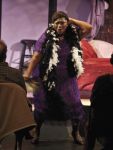A well-known movie star, up for an award for her portrayal of a maid in one of the year’s most critically-acclaimed films, is criticized by her own people accused of perpetuating a stereotype. No, not Viola Davis or Octavia Spencer, both up for Oscar Awards this month. Go back to 1939, when Hattie McDaniel received the statuette for her role as Mammy in “Gone with the Wind.”
 |
| SHAUNYCE OMAR PORTRAYS HATTIE McDANIEL
|
That same struggle in Hollywood is as American as apple pie and alive and well today, except that McDaniel didn’t have pioneers to inspire her path – she blazed it for others to follow. That is the one-woman tour-de-force performance in New Horizon Theater’s presentation of “Hi-Hat Hattie” in the Grey Box Theater in Lawrenceville earlier this month.
Written by Larry Parr, “Hi Hat Hattie” is a musical biography in first person that chronicles the daughter of slaves who chased her dream to become a famous actress despite being told that particular vocation was off limits to Coloreds. In spite of the obstacles and armed only with determination and a belief in her own innate talent, she made a name for herself.
In this production, directed by Eileen J. Morris and accompanied by musical director Henry Biggs on upright piano, Shaunyce Omar is our guide as she becomes Hattie McDaniel as she returns to the Old Orpheum Theatre in her hometown of Denver, the place where her dream first took root.
The youngest of 13 children born to former-slaves, Hattie’s family managed to give her a “middle class” upbringing (her father was a minister) and a firm faith that would later help her facing future adversities, of which there would be many. She first began her theater pursuits in order to be noticed amid her dozen siblings, she was noticed and commended for her talents and a star was born.
Given the times when White actors routinely performed in blackface, McDaniel clearly had her work cut out for her as Omar would share throughout her performance. Not only does Omar entertain with her energizing presence and her interaction with the audience, she provides an engaging history lesson in reminding that McDaniel was more than a groundbreaking actor commonly thought of in stereotypical roles.
As McDaniel, Omar reminds us that she did the best with what limited opportunities were available at the time, bringing dignity and integrity to her roles. After the stock market crash of 1929 and her first husband died, the only work she could find was as a washroom attendant. Despite the owner’s reluctance, McDaniel was hired as a fill in entertainer and eventually became a regular.
From there as time improved, her career took off. She was a singer-songwriter, recording artist, a comedian, stage actress in vaudeville and radio. She got the name “Hi Hat Hattie” through her work on radio as a bossy maid who frequently “forgot her place.” We learned that significant changes were made to the “Gone With the Wind” script (including the removal of the “n” word). And she commanded the respect of her fellow actors.
Unfortunately, McDaniel was also a victim of her success and the times. Despite the work that she did to support Black troops with the USO, and break up restriction covenants in upscale neighborhoods that would bar Blacks from owning property, she was ridiculed by the NAACP for the roles she and other Black actors played in a White dominated movie industry.
In the hands of Omar, Hattie McDaniel is a picture of perseverance and pride, as well as, a reminder of the trailblazer for Dorothy Dandridge, Lena Horne, Sidney Poitier, Sammy Davis Jr, Denzel Washington and Halle Berry. Omar is a force to be reckoned with—as was Hattie McDaniel.